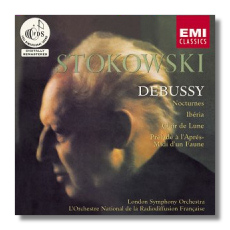
The Internet's Premier Classical Music Source
Related Links
- Debussy Reviews
- Latest Reviews
- More Reviews
-
By Composer
-
Collections
DVD & Blu-ray
Books
Concert Reviews
Articles/Interviews
Software
Audio
Search Amazon
Recommended Links
Site News
 CD Review
CD Review
Claude Debussy

- Prélude à l'après-midi d'un faune [1892-94]
- Three Nocturnes * [1897-99]
- Clair de Lune (from Suite Bergamasque, arr. Stokowski)
- Ibéria (from Images Pour Orchestre) ** [1905-08]
Leopold Stokowski Symphony Orchestra/Leopold Stokowski
* London Symphony Orchestra/Leopold Stokowski
** L'Orchestre National De La Radiodiffusion Française/Leopold Stokowski
EMI 67313
These are stunning performances and the recordings are excellent. Their existence has as much to do with Stokowski's work with the tapes as during the recording sessions. Stokowski knew how to use the recording medium to achieve a sound that was often 'better than live'. This was his goal and he met it head on.
The Leopold Stokowski Symphony Orchestra (sometimes dubbed "His" Symphony Orchestra) was an ad hoc group of some of the finest musicians in New York in the late fifties. They included such luminaries as Bob Bloom on oboe, Mason Jones on horn, Oscar Shumsky and/or Mischa Mischaokff on violin and, as credited here, Julius Baker on the flute. Twenty-four strings were the usual compliment, but using amplifying techniques during the recording and playing with the tapes afterwards, Stokowski made it sound like 68! You will never hear a more languid Prélude. The notes include a commentary by Leopold Stokowski where he opines, "The Prélude à l'après-midi d'un faune is a miracle of delicate, erotic beauty, suggesting a dream world of pagan loveliness, utterly original, in every way perfect." There are ten listed recordings Stokowski made of the piece, including two unpublished acoustic recordings. This 1957 recording should be in the collection of any serious lover of classical music. Of Clair de Lune, Stokowski wrote, "It suggests in a few notes a whole world of mystery and nocturnal beauty." Certainly Stokowski's orchestration captures that essence and it sounds as if Debussy himself had written it. The sound is much warmer than in their previous incarnation.
The other two items were previously released on another FDS recording (no longer available) and I can discern no difference in the sound. It was excellent then and is still so. The main reason for getting this disc, if you have the previous one, is the two new companions mentioned above. If, on the other hand, you don't have it, then prepare yourself for the finest Nocturnes you will ever hear. It is amazing how Stokowski gets the London Symphony to sound as French as the French orchestra in "Ibéria". It is a shame that Stokowski never recorded the whole Images, this is the most sensual recording of the Ibéria I know and that includes efforts by such greats as Pierre Monteux and Jean Martinon. In fact, while listening to this re-release I went back and revisited those two and as good as they are, I keep feeling they missed something. Stokowski's is so sensual you can almost smell it.
So, if you would like to spend an hour listening to some of the finest Debussy ever, snatch this up. If you are just "getting into" classical music and want an introduction to Debussy's sound world, this is not only your best bet, but will likely become a paradigm for you.
P.S. The notes include a few marvelous photographs of Stokowski in his New York apartment, in one he is pointing at the tape machine he loved to use.
Copyright © 2000, Robert Stumpf II


















